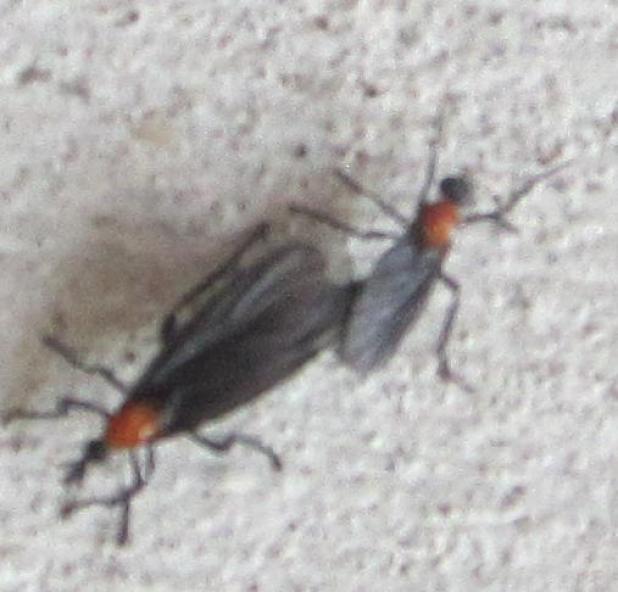
BUG LOVE
Mr. (right) and Mrs. Lovebug (left) have been “bugging” Avoyelles residents for the past few weeks after an annoying visit this past Spring. The insects only live a few days, in which time the female lays perhaps up to 600 eggs in Spring and late Summer. {Photo by Raymond L. Daye}
They're back: Lovebugs make second visit of the year
If you could’ve sworn you already survived lovebug season a few months ago and thought you were done, you are not losing your mind.
The black and red insect, usually seen flying slowly as a duo but sometimes solo, does not bite, sting or carry diseases. However, it is annoying as all get out and may prompt you to visit the car wash sooner than you had intended.
Entomologists -- bug scientists -- say there are two lovebug seasons in this region. Infestations are heavier some years than others.
Local entomologist and agriculture consultant Steve Mayeux of Cottonport said this summer hatching is heavier than most.
“In most summers we hardly notice the love bugs,” Mayeux said. “Maybe because it has been such a wet summer, there are more this year.”
The first hatching is usually in late March or early April and lasts about five weeks. The second season starts in late July or early August and is usually spent shortly after Labor Day.
The bug is found along the Gulf Coast, throughout the Southeast and down into Central America.
Some say it was created by the University of Florida -- an “experiment gone wrong” -- in an attempt to cross a fly with a mosquito to somehow control the mosquito problem. Some say the plan was to dupe love-blinded males to mate with a sterile female and others say the hybrid fly was to be some sort of anti-mosquito predator.
UF disputes the “mad scientist” theory. The bug scientists agree, placing the lovebug’s origin in Central America. It migrated north, entering the U.S. from Texas and then into Louisiana before heading east.
When lovebugs mate, they stay together -- literally -- ‘til death do them part.
That’s not as romantic as it sounds, since the larger female bug’s lifespan is only two to four days. The smaller male may live a day or two longer to mourn the loss of the love of his life.
Again, there is a dispute among the scientists who study the pest with some saying the female outlives the male.
Little lovebug “maggots” eat partially decayed vegetation, so they aren’t chewing up the flower garden or the tomatoes.
Online sources say the adult lovebug feeds on nectar -- again, no threat to gardeners’ interests. On this point, controversy once again rears its ugly head as some “lovebug-ologists” say adults don’t eat at all.
What just about everyone can agree on is that if the lovebug weren’t so annoying, it might avoid being Public Enemy No. 1 when it takes to the Avoyelles Parish skies in Spring and Summer.
REMOVE BUGS QUICKLY
If you drive into a swarm -- or cloud -- of lovebugs, Mayeux recommends you wash them off quickly. The tiny bug’s remains are acidic. The longer the corpse stays on the car, the more damage it will do to the paint and the harder it is to remove, he added. Scientists theorize that highways are a favorite congregating place for lovebugs because the smell of chemicals emitted in a car’s exhaust are similar to that of decaying vegetation. The bugs are also attracted to heat.
In short, you may not be hitting them, they may be hitting you.
Those national experts who have monitored the lovebug phenomenon over the past 70-plus years report that their numbers are not as large as they once were. The reason is that natural controls have caught up to the bug.
Local conditions can result in extremely large infestations from time to time, the experts note, but not in the thick black clouds of the ‘40’s ’50’s and ‘60’s.
Mayeux concurs, just from firsthand experience.
“When I was growing up, in the 1960’s and 1970’s, people’s windshields would be black with them,” he recalled.
The lovebug’s major enemy is a parasitic fungus. It also hates dry weather, which kills many of the fly’s larvae before they can earn their wings.
Because they have an acidic taste, the lovebug is not high on the insect-eating mammal, amphibian and reptile predators’ menu. However, less discerning birds, such as the robin, don’t turn their beaks up at the slow-moving “fast food” option.
Spiders, earwigs, centipedes and some varieties of beetle larvae will also help cull the herd.
LIFE CYCLE
The female disconnects from the male after a two-day “mating flight” to lay up to 350 eggs or as many as 600 eggs -- another point of disagreement among the experts.
The eggs hatch in about two days. Those laid in the warm spring remain larvae (maggots) for 120 days and then enter the pupa stage for a week or so before emerging as adults. Males mature first and then hover around the hatching site for the girls to show up.
The eggs laid in this outbreak will take over eight months to emerge to start their short but fruitful adult life. Short of a Shermanesque scorched earth campaign to burn all possible habitat for the larvae, all humans can do is wait for what has become an inevitable Spring swarm.
Because of their short lifespan, huge number and the fact they pose no threat to humans, “spraying insecticides to kill them is not an option,” Mayeux said.
The only other thing to do is hope and pray for a drier summer to reduce the numbers in the second infestation next August.
